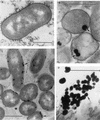Isolation of tellurite- and selenite-resistant bacteria from hydrothermal vents of the Juan de Fuca Ridge in the Pacific Ocean
- PMID: 12200320
- PMCID: PMC124112
- DOI: 10.1128/AEM.68.9.4613-4622.2002
Isolation of tellurite- and selenite-resistant bacteria from hydrothermal vents of the Juan de Fuca Ridge in the Pacific Ocean
Abstract
Deep-ocean hydrothermal-vent environments are rich in heavy metals and metalloids and present excellent sites for the isolation of metal-resistant microorganisms. Both metalloid-oxide-resistant and metalloid-oxide-reducing bacteria were found. Tellurite- and selenite-reducing strains were isolated in high numbers from ocean water near hydrothermal vents, bacterial films, and sulfide-rich rocks. Growth of these isolates in media containing K(2)TeO(3) or Na(2)SeO(3) resulted in the accumulation of metallic tellurium or selenium. The MIC of K(2)TeO(3) ranged from 1,500 to greater than 2,500 micro g/ml, and the MIC of Na(2)SeO(3) ranged from 6,000 to greater than 7,000 micro g/ml for 10 strains. Phylogenetic analysis of 4 of these 10 strains revealed that they form a branch closely related to members of the genus Pseudoalteromonas, within the gamma-3 subclass of the Proteobacteria. All 10 strains were found to be salt tolerant, pH tolerant, and thermotolerant. The metalloid resistance and morphological, physiological, and phylogenetic characteristics of newly isolated strains are described.
Figures




Similar articles
-
Metalloid reducing bacteria isolated from deep ocean hydrothermal vents of the Juan de Fuca Ridge, Pseudoalteromonas telluritireducens sp. nov. and Pseudoalteromonas spiralis sp. nov.Curr Microbiol. 2006 Nov;53(5):449-56. doi: 10.1007/s00284-006-0320-2. Epub 2006 Oct 19. Curr Microbiol. 2006. PMID: 17066332
-
Two distinct periplasmic enzymes are responsible for tellurite/tellurate and selenite reduction by strain ER-Te-48 associated with the deep sea hydrothermal vent tube worms at the Juan de Fuca Ridge black smokers.Arch Microbiol. 2017 Oct;199(8):1113-1120. doi: 10.1007/s00203-017-1382-1. Epub 2017 Apr 21. Arch Microbiol. 2017. PMID: 28432382
-
Anaerobic respiration on tellurate and other metalloids in bacteria from hydrothermal vent fields in the eastern Pacific Ocean.Appl Environ Microbiol. 2006 Jul;72(7):4950-6. doi: 10.1128/AEM.00223-06. Appl Environ Microbiol. 2006. PMID: 16820492 Free PMC article.
-
Effects of shallow-water hydrothermal venting on biological communities of coastal marine ecosystems of the western Pacific.Adv Mar Biol. 2006;50:267-421. doi: 10.1016/S0065-2881(05)50004-X. Adv Mar Biol. 2006. PMID: 16782453 Review.
-
The bacterial response to the chalcogen metalloids Se and Te.Adv Microb Physiol. 2008;53:1-72. doi: 10.1016/S0065-2911(07)53001-8. Adv Microb Physiol. 2008. PMID: 17707143 Review.
Cited by
-
Biomagnetic Recovery and Bioaccumulation of Selenium Granules in Magnetotactic Bacteria.Appl Environ Microbiol. 2016 Jun 13;82(13):3886-3891. doi: 10.1128/AEM.00508-16. Print 2016 Jul 1. Appl Environ Microbiol. 2016. PMID: 27107111 Free PMC article.
-
The thiol:disulfide oxidoreductase DsbB mediates the oxidizing effects of the toxic metalloid tellurite (TeO32-) on the plasma membrane redox system of the facultative phototroph Rhodobacter capsulatus.J Bacteriol. 2007 Feb;189(3):851-9. doi: 10.1128/JB.01080-06. Epub 2006 Nov 10. J Bacteriol. 2007. PMID: 17098900 Free PMC article.
-
Metalloid reducing bacteria isolated from deep ocean hydrothermal vents of the Juan de Fuca Ridge, Pseudoalteromonas telluritireducens sp. nov. and Pseudoalteromonas spiralis sp. nov.Curr Microbiol. 2006 Nov;53(5):449-56. doi: 10.1007/s00284-006-0320-2. Epub 2006 Oct 19. Curr Microbiol. 2006. PMID: 17066332
-
Plants and microbes assisted selenium nanoparticles: characterization and application.J Nanobiotechnology. 2014 Aug 16;12:28. doi: 10.1186/s12951-014-0028-6. J Nanobiotechnology. 2014. PMID: 25128031 Free PMC article.
-
Effects of trace element concentrations on culturing thermophiles.Extremophiles. 2012 Mar;16(2):317-31. doi: 10.1007/s00792-012-0432-5. Epub 2012 Feb 4. Extremophiles. 2012. PMID: 22311159
References
-
- Avazeri, C., R. J. Turner, J. Pommier, J. H. Weiner, G. Giordano, and A. Vermeglio. 1997. Tellurite reductase activity of nitrate reductase is responsible for the basal resistance of Escherichia coli to tellurite. Microbiology 143:1181-1189. - PubMed
-
- Bagnall, K. W. 1975. Selenium, tellurium, and polonium, p. 935-1008. In M. Schmidt, W. Siebert, and K. W. Bagnall (ed.), The chemistry of sulfur, selenium, tellurium and polonium. Pergamon Press, New York, N.Y.
-
- Butterfield, D. A., R. E. McDuff, M. J. Mottl, M. D. Lilley, J. E. Lupton, and G. J. Massoth. 1994. Gradients in the composition of hydrothermal fluids from the Endeavour segment vent field: phase separation and brine loss. Geophys. Res. 99:9561-9583.
-
- Conde, J. E., and M. Sanz Alaejos. 1997. Selenium concentrations in natural and environmental waters. Chem. Rev. 97:1979-2003. - PubMed
-
- Daniels, L. A. 1996. Selenium metabolism and bioavailability. Biol. Trace Elem. Res. 54:185-199. - PubMed
Publication types
MeSH terms
Substances
LinkOut - more resources
Full Text Sources
Other Literature Sources

